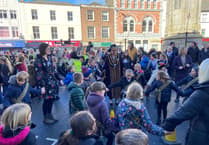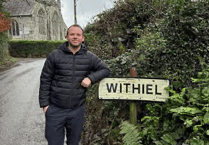PA23/06298: PLANS for 25 dwellings on land near Bude have hit the buffers after a reserved matters planning application for its development was refused by Cornwall Council.
Mr Paul Clark had applied to the local authority for a reserved matters application for the appearance, landscaping, layout and scale for a development of 25 dwellings and associated infrastructure at a location known as ‘The Pumpfield’ on land to the east of Stafford Close, Bude.
The reserved matters application followed the granting of outline consent in 2022 for the 25 properties, which gave permission for the work subject to the granting of reserved matters, meaning that further permission was required for any matter not specified in the initial granting of permission.
However, this permission has not been granted, potentially throwing a spanner into the works of the proposals.
Three reasons were stated for refusing the reserved matters application by Cornwall Council. These were the lack of affordable housing proposed, the lack of planting and parking and the absence of a detailed design proposed being supported by an objective assessment by a suitably qualified person, meaning the Council couldn’t be sure of risks to protected species.
An objection was also raised by Bude-Stratton Town Council, who said: “BSTC object to the housing mix, it is not meeting the housing need following the recent CC housing needs survey showing the need for 2/3 bedrooms dwellings.
“The primary purpose of a RES (rural exemption sites) is to provide affordable housing to meet local needs, where they are clearly, affordable housing led. The bedroom numbers shown in the Design and Access Statement of the application show 26 affordable bedrooms and 51 market value bedrooms.
“The affordable housing should be integrated and indistinguishable from the market value houses and the material palate / design should be identical.
“BSTC want to see the open spaces conditioned as land to be kept in perpetuity for the community.
“BSTC object to the lack of solar gain incorporated into the design, having no PV panels, no rainwater harvesting and no EV infrastructure. We object to the orientation of the dwellings which does not take into consideration any solar gain. There is no allocated parking area for the allotment spaces.
“BSTC request the inclusion of the Bude Green 5.
Refusing the application, Cornwall Council told the applicants: “The site is situated within a rural area and relates to a settlement considered suitable for housing on a rural exceptions basis only where housing development must be responsive to local circumstances in reflecting local housing needs and be affordable housing led.
“The proposed development is not considered to have been designed to be affordable housing led working back from 100% affordable housing as required by the Cornwall Local Plan and the Section 106 Agreement: the financial viability information provided fails to clearly demonstrate how the scheme has worked back from a 100% starting point, with only the minimum number of open market homes included to make the scheme viable; the proposed development layout shows less than 50% of the site area given over to affordable housing and the proposed affordable housing mix does not reflect the identified local need in terms of the number bedrooms or minimum size requirements.
The proposal is therefore considered to conflict with Policies 1, 2, 3, 9 and 10 of the Cornwall Local Plan Strategic Policies 2010-2030, Policy 1 of the Bude-Stratton Neighbourhood Development Plan 2016 - 2030 February 2016 and the aims and intentions of paragraphs 8, 11, 60, 62 and 78 of the National Planning Policy Framework 2023.
The proposed development would, utilise a standard car led road layout that is absent of features such as street trees; - detail a reliance for on plot vehicle parking and is absent of any dedicated parking for visitors or users of the allotments.
It would rely on tree planting being predominately located within private ownership where pressure for removal and less certainty of retention is likely to occur.
“Further, it will be absent of above ground non-buried SuDS which can assist in creating a sense of place, amenity and biodiversity whilst reducing the overall level of flood risk on the site and the surrounding areas.
“It would have boundaries facing key open spaces and areas that are predominately long lengths of close boarded timber fencing or hedges at the two entrances to the Biodiversity Mitigation space.
“This would prevent entry to connect to the hoggin path shown and which in combination with the orientation of dwellings fails to create natural surveillance of open spaces, have larger undefined hedge boundaries which create a significant break between the site boundary and private gardens in particular to the North of the site.
“It is unclear how these areas would be managed or function to prevent activities such as anti-social behaviour, littering or depositing of garden waste.
“It would fail to distribute affordable housing across the site and for it to be indistinguishable from the open market homes, fails to deliver homes that meet a local housing need and meet the Nationally Described Space Standards for the required bedrooms and bedspaces.
“It would fail to detail how the carbon footprint of the development and the use of renewable energy, water and waste recycling and energy efficiency measures would be delivered.
In combination all these factors would represent poor design and fail to create a successful, sustainable, socially cohesive place that will function well and add to the overall quality of the area, not just for the short term but over the lifetime of the development.
In the absence of the detailed design proposed being supported by an objective assessment by a suitably qualified person to demonstrate otherwise and when undertaking a precautionary approach, the Local Planning Authority cannot be satisfied that this scheme will not harm protected species, including but not limited to bats and reptiles, and hence the development is inconsistent with the aims of the Cornwall Local Plan Strategic Policies 2010-2030, paragraphs 174 and 180 of the National Planning Policy Framework 2023. Further, the application fails the statutory derogation tests as it would introduce a disturbance to foraging and commuting bats or reptiles and there is no imperative reason of overriding public interest for the development due to the development failing to respond to local circumstances in reflecting local housing needs and being affordable housing led.
PA23/03211: RETROSPECTIVE planning permission for an extension to an existing building for use as a self contained annexe to a main building for a property near Lanivet has been refused by Cornwall Council’s planning team.
Mr Wayne Sturgess applied to the local authority for permission to undertake the works at land on Mena Barn, Lanivet, Bodmin.
Refusing the application, Cornwall Council’s planning team told the applicants: “The application proposes the retention of a dwelling built without permission.
“The dwelling is located within the open countryside and has introduced built form and domestic paraphernalia that erodes the previously undeveloped agricultural characteristics of the site eroding the contribution the site makes to landscape character.
“No special justification has been provided for a dwelling in the countryside, which is not considered to be annexe accommodation, and the proposal causes conflict with the spatial strategy pursued under the development plan and causes landscape harm.
“The proposal is contrary to the aims and objectives of policies of the Cornwall Local Plan Strategic Policies 2010 - 2030, the National Planning Policy Framework 2023 and the Climate Emergency Development Plan Document 2023.
“The modest benefits of the proposal do not outweigh the landscape harm and conflict with the spatial strategy and does not amount to sustainable development.”




